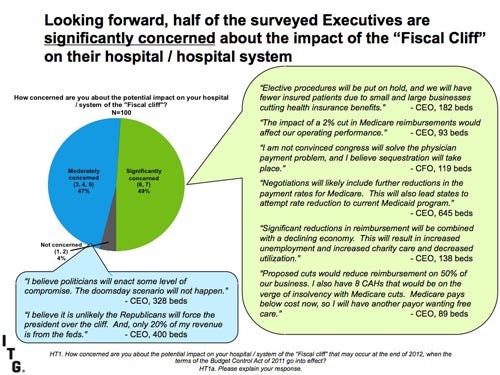Fiscal Cliff Leaves Device Makers in a Bind…and in Limbo
The passage of a scaled-back fiscal cliff agreement late last week, contained no relief for medical device makers. Key issues remained unresolved, and cuts to medicare reimbursement, imaging, and diabetes disappoint device associations.A new report from ITG explores what hospital executives thought of the fiscal cliff and its impact for hospitals. Most executives who responded to the survey, which was conducted in Q4 of 2012 (before the fiscal cliff deal was ratified), predicted the difficulties.
January 2, 2013
The passage of a scaled-back fiscal cliff agreement late last week, contained little relief for medical device makers. Key issues remained unresolved, and cuts to medicare reimbursement, imaging, and diabetes disappointed various associations across the healthcare industry.
|
View a larger version of this image. Details about ITG's Hospital Executive research and a downloadable report can be purchased through ITG Market Research. |
A new report from ITG explores what hospital executives thought of the fiscal cliff and its impact for hospitals. Most executives who responded to the survey, which was conducted in Q4 of 2012 (before the fiscal cliff deal was ratified), predicted the difficulties.
Of the respondents, 47% said they were mildly concerned and 49% said they were significantly concerned. Issues brought up by those most concerned with the fiscal cliff included cuts to reimbursement, physician payment problems, and a reduction in elective procedures. The executives were right to worry.
Advamed released a statement today expressing its disappointment that some of the cuts in the package included imaging and diabetes related services. “We believe these cuts will hurt access to important technologies that Medicare beneficiaries depend upon,” said Stephen J. Ubl, president and CEO of AdvaMed in the statement.
Several issues were decided in this round of the fiscal cliff deal that could have implications for hospitals and medical device makers. Most of these (outlined at the end of this article) focus on reduced reimbursement for various therapies, adjustments to how overpayments are recouped, changes how imaging equipment is reimbursed, and enables greater competition for diabetes test strips.
The fiscal cliff also hurts hospitals more than doctors, according to the Washington Post. One key issue in the fiscal cliff was physician payments. Congress temporarily fixed the problem with doctor's salaries by introducing about $15 billion in cuts to reimbursement. Essentially, the deal solved one aspect of healthcare at the expense of another.
Other budget issues folded in the fiscal cliff have been given an extension. Spending cuts through sequestration, which includes user fees paid to FDA, among other sources, will be decided by Congress in February.
In addition, although parts of Obamacare were repealed, the device tax was not among the them. Ubl said that Advamed would not give up its campaign for repeal of the device tax. “We urge Congress to repeal the device tax . . . so that we can avoid going over the medical technology innovation cliff.” He vowed, “The effort to repeal the medical device tax will continue.”
Medical Device-Related Cuts in the Fiscal Cliff Deal
Recoup of past overpayments to hospitals made as a result of the transition to Medicare Severity Diagnosis Related Groups (MS-DRGs). Savings: $10.5 billion.
Reprice End Stage Renal Disease (ESRD) payments to take into account changes in behavior and utilization of drugs for dialysis. Savings: $4.9 billion.
Reduce reimbursement payments for therapies when multiple therapies are provided on the same day. Savings: $1.8 billion.
Equalize payments for stereotactic radiosurgery services provided under Medicare hospital outpatient payment system. Savings: $0.3 billion.
Increase the utilization factor (the ratio of time that a piece of equipment is in use to the total time that it could be in use) used in the setting of payment for imaging services in Medicare from 75% to 90%. Savings: $0.8 billion.
Apply competitive bidding to diabetic test strips purchased at retail pharmacies. Savings: $0.6 billion.
Reduce the payment rates for ambulance services by 10% for individuals with ESRD obtaining non-emergency basic life support services involving transport. Savings: $0.3 billion.
Increase statute of limitations for recovering overpayments from three to five years. Savings: $0.5 billion.
Eliminate funding for the Medicare Improvement Fund. Savings: $1.7 billion.
Rebase Medicaid Disproportionate Share Hospital (DSH) payments to extend the changes from the Affordable Care Act (ACA) for an additional year. Savings: $4.2 billion.
Repeal Community Living Assistance Services and Supports (CLASS) program established by the Affordable Care Act. This provision has no scoring implications.
Establish the Commission on Long Term Care to develop a plan to establish, implement, and finance a high quality system that ensures the availability of long-term services and supports for individuals. This provision has no scoring implications.
Adjust coding intensity to reflect differences in coding practices between Medicare fee-for-service and Medicare Advantage. This provision increases this coding intensity adjustment. Savings: $2 billion.
Rescind all unobligated CO-OP funds under section 1332(g) of the Affordable Care Act. Savings: $2.3 billion
More On the Fiscal Cliff
Cuts to User Fees and CDRH Funding Threaten Medical Devices
About the Author(s)
You May Also Like


.png?width=300&auto=webp&quality=80&disable=upscale)
